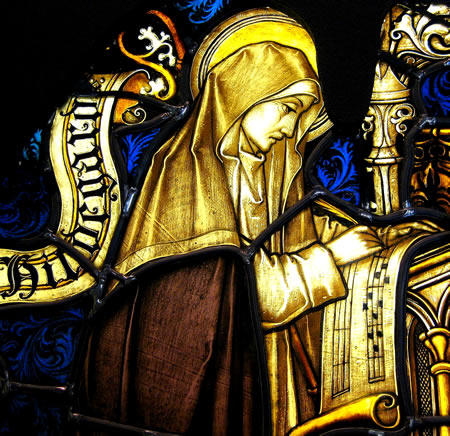 |
| Hildegard of Bingen - Theologian and Visionary |
Hildegard of Bingen was an abbess, theologian, scientist, musician, preacher, and visionary who wrote major theological works. She was also called Sybil of the Rhine. She was the last and 10th child of Hildebert of Bermersheim and Mechthild of Merxheim.
The wealthy couple had promised her as a tithe to the church, which was a traditional practice at the time. Some sources indicate that Hildegard received a religious, but very basic education from a kindly anchoress, Jutta, daughter of Count Stephen of Sponheim. She learned some Latin but always felt inadequate in the language. Her exposure to religious music enabled her to compose songs later in life.
Some sources state that Hildegard stayed at Count Stephen’s estate until she took the veil at 14. When Jutta died in 1136 Hildegard became the abbess of what had become a Benedictine convent at Disidodensberg. Years later in her book Scivias, Hildegard disparaged the practice of making young children oblates to the church.
Hildegard had visions as early as age three but told no one. She eventually told Jutta, who was accepting of the visions. She also confided in Volmar, a monk who shared her trials and tribulations. Modern medical knowledge has ascertained that Hildegard suffered from severe migraine headaches.
At the age of 42, when Hildegard had a particularly brilliant vision, she accepted her gift and was instructed by Pope Eugenius (1145–53) to publish what she saw; the result was Scivias. Hildegard’s convent grew in size, compelling her move to nearby Bingen. She also founded a convent at adjacent Eibingen.
Hildegard occupied herself by writing music and plays. She also wrote more visionary books: Liber vitae meritorum from 1150 to 1152 and Liber divinorum operum in 1163, which contained her ideas of microcosm and macrocosm. She argued that man was God’s most perfect creation, thus a reflection from which the macrocosm was replicated.
Hildegard also wrote nonvisionary works. Physica discussed natural history and Causae et Curae (1150) discussed medical history and elaborated how natural elements could cure illness. Together they are known as Liber subtilatum.
She was ahead of her time in discussing female sexual pleasure during intercourse and deemed the male responsible for producing strong offspring with healthy semen. Hildegard believed that music was a divine instrument given to Adam after the Fall so that God would be appropriately worshiped.
She wrote numerous hymns that honored virgins, saints, and Mary. Much of her music has been recorded, especially in honor of her 900th anniversary. Hildegard also maintained a wide-ranging correspondence with many political leaders and bishops. At one time five emperors heeded Hildegard’s advice.
EmoticonEmoticon